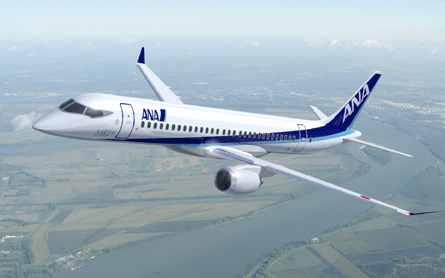Mitsubishi Aircraft says that around half of the double-digit operating cost advantage claimed for its MRJ regional jet over the rival Embraer E-Jet family comes from its advanced airframe technology, and the remainder from its Pratt & Whitney PW1000G geared turbofan engines.
The 88- to 92-seat MRJ90's cash operating cost advantage over the similarly sized Embraer 190 is "28% on a per-trip basis and 16% on a per-seat/mile basis", claims Mitsubishi Aircraft's marketing director Yugo Fukahara speaking at the Singapore air show. "The majority of the cash operating cost advantage comes from fuel burn and half of this comes from the engine and half from the airframe," he adds.
The airframer remains bullish about the contribution of the new twinjet's airframe design and structure delivers to its greater efficiency over rivals, despite last year's decision to adopt a majority aluminium structure after dropping plans for a carbonfibre wing.
 |
|---|
Although the latest MRJ brochure claims "advanced aerodynamics and cutting-edge technology with the use of composite materials", as a result of the wing structure rethink the only remaining composite parts are the empennage, horizontal tail and vertical tail, amounting to 10-15% of the total airframe.
The MRJ90, which is the lead variant and due to enter service with launch customer All Nippon Airways in early 2014, has 31% lower block fuel burn per trip and 18% better block fuel burn per seat over the E-190, claims Mitsubishi. "What this means is a $1.25 million advantage per aircraft per year," says the company's executive vice-president Junichi Miyakawa.
The advantage over the MRJ's Asian rival, China's GE CF34-powered Comac ARJ21, is potentially even greater, says Miyakawa. While the specific ARJ21 performance data is unavailable for a true comparison, Miyakawa estimates that its disadvantage to the MRJ is similar that of the Rolls-Royce Tay-powered Fokker 100, which has around 40% higher fuel burn per trip.
Meanwhile, Miyakawa says that the MRJ's development programme is "on track". The preliminary design review was achieved last year when the "outer mould line" and sizing of major structural elements was completed. "The critical design review, or design freeze, will be reached by the end of the summer," he adds. The programme remains on course to achieve a first flight by mid-2012.
- All the latest news, images and video from the 2010 Singapore Airshow
Source: Flight International























